 |

Part 3 (In Production) The American people know that the Chinese people built the railroad. And often that's the one and only thing they know. And that's exactly the problem." -Professor Patricia Limerick The third program in the series begins in the 1860s and ends in the 1930s when other key Asian groups--Japanese, Asian Indians, Koreans and Filipinos--have arrived and settled in America, and the second generation of Chinese immigrants is establishing itself. Program 3 starts with a revealing look at the Chinese role and sacrifices in building the western half of the monumental Transcontinental Railroad. Their actual experience is a part of our history which is not commonly known today. Here, the Chinese were 80 - 90% of the workforce and built one of the most difficult parts of the railroad, over the Sierra Nevada mountain range. They were forced to work from sun up to sun down, labor in very dangerous conditions, and sleep in tents in the middle of winter, without any protection against the cold or avalanches which swept whole camps down mountainsides.
In the decade following their completion of the railroad, Chinese labor was no longer critical in the west. Paradoxically, the completion of the railroad made it possible for competing white labor to come from other parts of the country and world. These workers acted on their assumptions of white superiority by "righteously" displacing, replacing or expelling the "heathen foreigners" from any occupation they wanted, including ones that the "foreigners" had pioneered. With a nationwide depression in the 1870s - 1890s as the backdrop, the film will show how anti-Chinese sentiment grew as Chinese laborers were cast as scapegoats for these economic troubles. During this period there were also mounting labor troubles, and the Chinese were repeatedly used as replacement labor, creating further resentment. We see how Chinese labor was specifically useful to business owners because it combined two qualities: the Chinese were disciplined but subordinated, and they were racially unacceptable to white labor unions, with whom they therefore would never be joined. Furthermore, they were also legally rendered "perpetual foreigners", without any political power to protest or contest the terms or conditions of their employment. "The employers of various large industries...were incredibly canny and thoughtful about dividing the labor force. And so, they very consciously, intentionally used Chinese people as strikebreakers, knowing that that will infuriate and mortify white workers, that that will drive them into outraged and self-destructive behavior." As a result of their status, Chinese laborers became quite useful to various companies, who brought them into several regions of the country specifically where there were labor troubles: into Louisiana cotton plantations to "discipline" freed blacks; into Belleville, New Jersey, laundries to counter "uppity" Irish washerwomen; into a North Adams, Massachusetts, shoe factory to break a strike; and into the coal mines at Rock Springs, Wyoming, to counter the union organizing actions of the Knights of Labor. This strategic positioning and movement of cheap labor also helped disperse the Chinese geographically across the United States. Outbreaks of anti-Chinese hatred, riots and violent expulsions became common all over the west. The film chronicles the worst incident: the infamous massacre of Chinese coal miners at Rock Springs, Wyoming. Mine owner Union Pacific brought the Chinese into Rock Springs as strike breakers in 1875. Ten years later, Chinese coal miners reaped the harvest of the hatred that had been building against them when an angry mob shot them down by the dozens and burned their village to the ground. President Grover Cleveland called out Federal troops to restore peace, and later paid reparations to the Chinese from the town. We see as well the role of political opportunism in the way that anti-Chinese sentiment infused the highest levels of government, as California Governor George C. Perkins proclaimed March 4, 1880, a legal state holiday for anti-Chinese demonstrations. The program will show how 30 years of unrelenting anti-Chinese sentiment culminated in the U.S. Congress passing the unprecedented Chinese Exclusion Act in 1882, which halted further immigration of virtually all Chinese as well as other "Asiatics" to whom the same law was applied in succession: Japanese, Asian Indian, Filipino, Koreans. The Exclusion Act also prevented Asians already residing in the U.S., including American-born offspring, from becoming naturalized citizens. "The Chinese Exclusion Act...is the The Chinese Exclusion Act was a milestone in immigration policy--the first major restriction on immigration to America. The film will show how Chinese immigrants learned to use the U.S. court system to challenge exclusion and many other forms of discrimination, often all the way to the U.S. Supreme Court. Although the Exclusion Act was not fully repealed until 1943, when China was America's wartime ally, there were many other precedent-setting legal victories prior to this, which greatly expanded basic civil and human rights in America--long before the civil rights movements of the 1950s and 1960s. Ultimately, Chinese and other Asian immigrants brought more than 170 cases before the U.S. Supreme Court in the 19th and early 20th centuries. One of the most important cases is Wong Kim Ark v. The United States, an 1897 U.S. Supreme Court decision that for the first time established the legal right of citizenship by birth for all Americans, more clearly defining the 14th amendment. Another important case was the 1885 Yick Wo v. Hopkins, in which a Chinese Laundrymen guild won "equality before the law" with regards to regulations on their livelihood. Program 3 will also portray the case of Mamie Tape, an 8-year-old Chinese American girl whose parents fought for her to be admitted to the all-white Spring Valley School in San Francisco in 1885. Her descendants help tell this pioneering story of school desegregation.
In addition, Program 3 will put Asians in America within the context of world events. By the early 1900s the U.S. was becoming an international power and looking beyond its western shores to the lands across the Pacific, to Hawaii and Philippines. "The Far East has now become our Far West", declared Secretary of State John Hay. But the influence was not one way. Program 3 will show how the American experience of Asian immigrants, despite the discrimination they faced and fought, provided ideological inspiration and practical support for the formation of nationalist and democratic movements in their homelands in the early 20th century. Seeking to establish a new republic to replace a crumbling, millennia-old monarchy system, the Chinese in China sent out a clarion call for the patriotic support and aid of their former countrymen in America. The reliable response of "overseas" Chinese, especially those in America, helped financed the revolution that gave birth to the Chinese Republic in 1911. In parallel fashion, Asian Indians in California and the Pacific Northwest, longing to throw off British control of India, formed the Ghadar Revolutionary Party in San Francisco, and Korean Americans in Hawaii and California established similar organizations to throw off Japan's domination of Korea. By the conclusion of Program 3 we see how and why all the early Asian immigrant groups--Chinese, Japanese, Filipino, Asian Indian, and Korean--arrived and started their American communities by the second decade of the 20th century. "[Asian immigrant] cases did profoundly affect the course of American jurisprudence, contributing in a significant way to the molding of 14th Amendment due process and equal protection." -Professor Charles McClain Finally, we see how these immigrants and their contributions to America collectively set the stage for the renewed Asian immigrations that followed in the latter half of the 20th century, driven by changes brought about by WWII, the civil rights movement and the Vietnam War. If you would like to be notified when Program 3 is completed, please signup for our email list. home | about cet | about Loni Ding | cet productions resources | mailing list | order | site credits | contact us ancestors | guides | documents | discover ancestors Copyright 1998-2009. Center for Educational Telecommunications, Inc. All Rights Reserved.
|
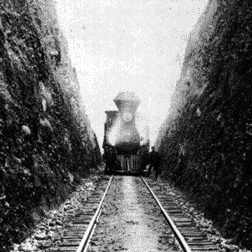 "That famous picture for the completion of the Transcontinental Railroad where the Golden Spike is about to be hammered in....Many have noted that the Chinese are not there. So you have what seems to be a strange and sad irony that the Chinese did the labor and they're not in the picture."
"That famous picture for the completion of the Transcontinental Railroad where the Golden Spike is about to be hammered in....Many have noted that the Chinese are not there. So you have what seems to be a strange and sad irony that the Chinese did the labor and they're not in the picture."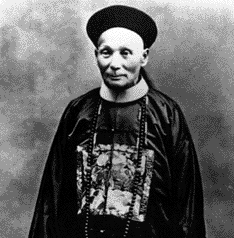
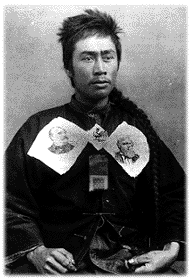
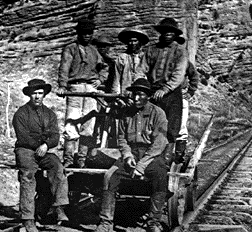
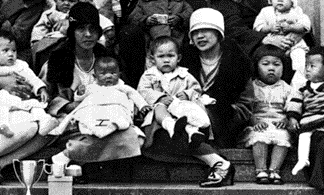 "A hundred years ago I would not have been able to go to school here....Jennie Hurley, the school principal, stood at the door to bar Mamie Tape from entering. Today, I, a Chinese American, am the principal, and it is my role to stand at the gate and welcome all children."
"A hundred years ago I would not have been able to go to school here....Jennie Hurley, the school principal, stood at the door to bar Mamie Tape from entering. Today, I, a Chinese American, am the principal, and it is my role to stand at the gate and welcome all children."



